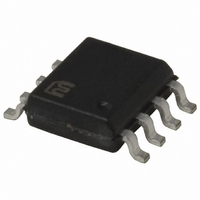MIC384-2BM Micrel Inc, MIC384-2BM Datasheet - Page 18

MIC384-2BM
Manufacturer Part Number
MIC384-2BM
Description
IC SUPERVSR THERM LOC/REM 8SOIC
Manufacturer
Micrel Inc
Datasheet
1.MIC384-0YM.pdf
(22 pages)
Specifications of MIC384-2BM
Function
Temp Monitoring System (Sensor)
Topology
ADC (Sigma Delta), Register Bank
Sensor Type
External & Internal
Sensing Temperature
-55°C ~ 125°C, External Sensor
Output Type
I²C™/SMBus™
Output Alarm
Yes
Output Fan
No
Voltage - Supply
2.7 V ~ 5.5 V
Operating Temperature
-55°C ~ 125°C
Mounting Type
Surface Mount
Package / Case
8-SOIC (3.9mm Width)
Lead Free Status / RoHS Status
Contains lead / RoHS non-compliant
MIC384
Applications
Remote Diode Selection
Most small-signal PNP transistors with characteristics similar
to the JEDEC 2N3906 will perform well as remote temperature
sensors. Table 6 lists several examples of such parts that
Micrel has tested for use with the MIC384. Other transistors
equivalent to these should also work well.
Minimizing Errors
Self-Heating
One concern when using a part with the temperature accuracy
and resolution of the MIC384 is to avoid errors in measuring
the local temperature induced by self-heating. Self-heating
is caused by the power naturally dissipated inside the device
due to operating supply current and I/O sink currents (V
I
this represents, and how to reduce that error, the dissipation
in the MIC384 must be calculated and its effects reduced to
a temperature offset.
The worst-case operating condition for the MIC384 is when
V
sipated in the part is given in Equation 1 below.
In most applications, the /INT output will be low for at most
a few milliseconds before the host resets it back to the high
state, making its duty cycle low enough that its contribution to
self-heating of the MIC384 is negligible. Similarly, the DATA
pin will in all likelihood have a duty cycle of substantially less
than 25% in the low state. These considerations, combined
with more typical device and application parameters, give a
better system-level view of device self-heating in interrupt-
mode. This is illustrated in Equation 2.
If the part is to be used in comparator mode, calculations
similar to those shown above (accounting for the expected
value and duty cycle of I
the temperature error due to self-heating.
In any application, the best test is to verify performance
MIC384
DD
DD
) + (V
= 5.5V, MSOP-08 package. The maximum power dis-
OL
× I
OL
). In order to understand what level of error
[(0.35mA I
∆T
∆T
J
J
= (1.27mW x 206°C/W)
= 0.262°C
OL(INT)
Table 6. Transistors Suitable for Remote Temperature Sensing Use
DD(typ)
P
P
P
R
Maximum ∆T
Vendor
Fairchild
On Semiconductor
Phillips Semiconductor
Samsung
D
D
D
q(j-a)
= [(I
= [(0.75mA x 5.5V) + (6mA x 0.8V) + (6mA x 0.8V)]
= 13.73mW
) will give a good estimate of
of MSOP - 08 package is 206°C/W
x 3.3V) + (25% x 1.5mA I
DD
x V
Equation 2. Real-World Self-heating Example
J
DD
relative to T
) + (I
Equation 1. Worst-Case Self-Heating
OL(DATA)
A
due to self heating is 13.73mW x 206°C/W = 2.83°C
) x V
OL(DATA)
DD
OL(DATA)
Part Number
MMBT3906
MMBT3906L
PMBT3906
KST3906-TF
×
) x 0.3V) + (1% x 1.5mA I
18
+ (I
against calculation in the final application environment. This
is especially true when dealing with systems for which some
of the thermal data (e.g., PC board thermal conductivity and
ambient temperature) may be poorly defined or unobtainable
except by empirical means.
Series resistance
The operation of the MIC384 depends upon sensing the
ΔV
different current levels. For remote temperature measure-
ments, this is done using external diodes connected between
T1, T2 and ground.
Since this technique relies upon measuring the relatively
small voltage difference resulting from two levels of current
through the external diodes, any resistance in series with
those diodes will cause an error in the temperature read-
ing from the MIC384. A good rule of thumb is this: for each
ohm in series with a zone's external transistor, there will be
a 0.9°C error in the MIC384’s temperature measurement. It
isn’t difficult to keep the series resistance well below an ohm
(typically < 0.1Ω), so this will rarely be an issue.
Filter capacitor selection
It is sometimes desirable to use a filter capacitor between
the T1 and/or T2 pins and the GND pin of the MIC384. The
use of these capacitors is recommended in environments
with a lot of high frequency noise (such as digital switching
noise), or if long wires are used to attach to the remote di-
odes. The maximum recommended total capacitance from
the T1 or T2 pin to GND is 2700pF. This typically suggests
the use of 2200pF NP0 or C0G ceramic capacitors with a
10% tolerance.
If a remote diode is to be at a distance of more than ≈ 6"—12"
from the MIC384, using twisted pair wiring or shielded micro-
phone cable for the connections to the diode can significantly
help reduce noise pickup. If using a long run of shielded
cable, remember to subtract the cable’s conductor-to-shield
capacitance from the 2700pF maximum total capacitance.
OL(/INT)
CB-E
of a diode-connected PNP transistor (“diode”) at two
x V
OL(/INT)
Package
)]
SOT-23
SOT-23
SOT-23
SOT-23
OL(/INT)
x 0.3V)] = 1.27mW
September 2005
Micrel












